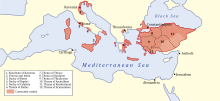Pope Stephen II was born a Roman aristocrat and member of the Orsini family. Stephen was the bishop of Rome from 26 March 752 to his death. Stephen II marks the historical delineation between the Byzantine Papacy and the Frankish Papacy. During Stephen's pontificate, Rome was facing invasion by the Lombards when Stephen II went to Paris to seek assistance from Pepin the Short. Pepin defeated the Lombards and made a gift of land to the pope, eventually leading to the establishment of the Papal States.
Pope Gregory II was the bishop of Rome from 19 May 715 to his death. His defiance of Emperor Leo III the Isaurian as a result of the iconoclastic controversy in the Eastern Empire prepared the way for a long series of revolts, schisms, and civil wars that eventually led to the establishment of the temporal power of the popes.

Pope Gregory III was the bishop of Rome from 11 February 731 to his death. His pontificate, like that of his predecessor, was disturbed by Byzantine iconoclasm and the advance of the Lombards, in which he invoked the intervention of Charles Martel, although ultimately in vain. He was the last pope to seek the consent of the Byzantine exarch of Ravenna for his election, the last pope of Syrian origin, and the last non-European pope until the election of Pope Francis more than 1,271 years later in 2013.

Pope Zachary was the bishop of Rome from 28 November 741 to his death. He was the last pope of the Byzantine Papacy. Zachary built the original church of Santa Maria sopra Minerva, forbade the traffic of slaves in Rome, negotiated peace with the Lombards, and sanctioned Pepin the Short's usurpation of the Frankish throne from Childeric III. Zachary is regarded as a capable administrator and a skillful and subtle diplomat in a dangerous time.

The Holy See exercised sovereign and secular power, as distinguished from its spiritual and pastoral activity, while the pope ruled the Papal States in central Italy.
Eutychius was the last Exarch of Ravenna, heading the Exarchate from 726 or 727 until 751.

Aistulf was the Duke of Friuli from 744, King of the Lombards from 749, and Duke of Spoleto from 751. His reign was characterized by ruthless and ambitious efforts to conquer Roman territory to the extent that in the Liber Pontificalis, he is described as a "shameless" Lombard given to "pernicious savagery" and cruelty.

The Exarchate of Ravenna, also known as the Exarchate of Italy, was an administrative district of the Byzantine Empire comprising, between the 6th and 8th centuries, the territories under the jurisdiction of the exarch of Italy resident in Ravenna. The term is used in historiography in a double sense: "exarchate" in the strict sense denotes the territory under the direct jurisdiction of the exarch, i.e. the area of the capital Ravenna, but the term is mainly used to designate all the Byzantine territories in continental and peninsular Italy. According to the legal sources of the time, these territories constituted the so-called Provincia Italiae, on the basis of the fact that they too, until at least the end of the 7th century, fell under the jurisdiction of the exarch and were governed by duces or magistri militum under him.
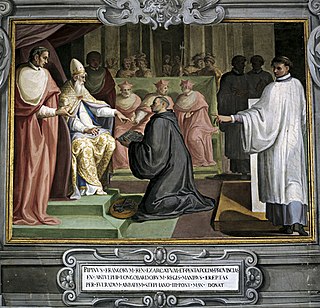
The Donation of Pepin in 756 provided a legal basis for the creation of the Papal States, thus extending the temporal rule of the popes beyond the duchy of Rome.

The Duchy of Spoleto was a Lombard territory founded about 570 in central Italy by the Lombard dux Faroald. Its capital was the city of Spoleto.

Liutprand was the king of the Lombards from 712 to 744 and is chiefly remembered for his multiple phases of law-giving, in fifteen separate sessions from 713 to 735 inclusive, and his long reign, which brought him into a series of conflicts, mostly successful, with most of Italy. He is often regarded as the most successful Lombard monarch, notable for the Donation of Sutri in 728, which was the first accolade of sovereign territory to the Papacy.
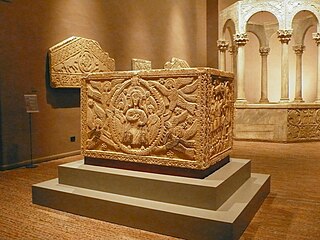
Ratchis was the Duke of Friuli (739–744) and then King of the Lombards (744–749).

The Donation of Sutri was an agreement reached at Sutri by Liutprand, King of the Lombards and Pope Gregory II in 728. At Sutri, the two reached an agreement by which the city and some hill towns in Latium were given to the Papacy, "as a gift to the blessed Apostles Peter and Paul" according to the Liber Pontificalis. The pact formed the first extension of papal territory beyond the confines of the Duchy of Rome and was the first of two land transfers from Liutprand to the Church of Rome.
The Patrimony of Saint Peter originally designated the landed possessions and revenues of various kinds that belonged to the apostolic Holy See. Until the middle of the 8th century this consisted wholly of private property; later, it corresponded to the territories under Papal sovereignty, but from the early 13th century the term was applied to one of the four provinces of the States of the Church.
Transamund II was the Lombard Duke of Spoleto from 724 to 745, though he was twice driven from power by the king, Liutprand. Transamund rose to power by deposing his own father, Faroald II, and tonsuring him in a monastery.
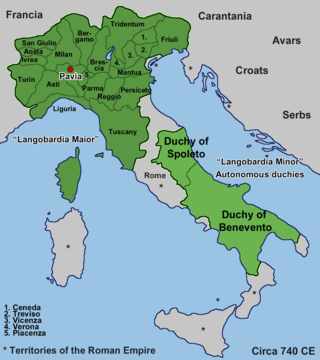
The Kingdom of the Lombards, also known as the Lombard Kingdom and later as the Kingdom of all Italy, was an early medieval state established by the Lombards, a Germanic people, on the Italian Peninsula in the latter part of the 6th century. The king was traditionally elected by the very highest-ranking aristocrats, the dukes, as several attempts to establish a hereditary dynasty failed. The kingdom was subdivided into a varying number of duchies, ruled by semi-autonomous dukes, which were in turn subdivided into gastaldates at the municipal level. The capital of the kingdom and the center of its political life was Pavia in the modern northern Italian region of Lombardy.
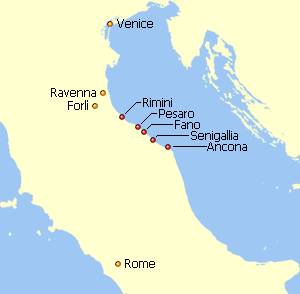
In the Byzantine Empire, the Duchy of the Pentapolis was a duchy, a territory ruled by a duke (dux) appointed by and under the Exarch of Ravenna. The Pentapolis consisted of the cities of Ancona, Fano, Pesaro, Rimini and Sinigaglia. It lay along the Adriatic coast between the rivers Marecchia and Misco immediately south of the core territory of the exarchate ruled directly by the exarch, east of the Duchy of Perugia, another Byzantine territory, and north of the Duchy of Spoleto, which was part of the Lombard Kingdom of Italy. The duchy probably extended inland as far as the Apennine Mountains, perhaps beyond, and its southernmost town was Humana (Numera) on the northern bank of the Misco. The capital of the Pentapolis was Rimini and the duke was both the civil and military authority in the duchy.

The Duchy of Perugia was a duchy in the Italian part of the Byzantine Empire. Its civil and military administration was overseen by a duke (dux) appointed by and under the authority originally of the Praetorian Prefect of Italy (554–584) and later of the Exarch of Ravenna (584–751). Its chief city and namesake was Perugia (Perusia), located at its centre. It was a band of territory connecting the Duchy of the Pentapolis to its northeast with the Duchy of Rome to its southwest, and separating the duchies of Tuscia and Spoleto, both parts of the Lombard Kingdom of Italy. It was of great strategic significance to the Byzantines since it provided communication between Rome, the city of the Popes, and Ravenna, the capital of the Exarchate. Since it cut off the Duke of Spoleto from his nominal overlord, the king ruling from Pavia, it also disturbed the Lombard kingdom, which was a constant thorn in the Byzantines' side. This strategic importance meant that many Lombard and Byzantine armies passed through it.

The Byzantine–Lombard wars were a protracted series of conflicts which occurred from AD 568 to 750 between the Byzantine Empire and a Germanic tribe known as the Lombards. The wars began primarily because of the imperialistic inclinations of the Lombard king Alboin, as he sought to take possession of Northern Italy. The conflicts ended in a Byzantine defeat, as the Lombards were able to secure large parts of Northern Italy at first, eventually conquering the Exarchate of Ravenna in 750.

The papal nobility are the aristocracy of the Holy See, composed of persons holding titles bestowed by the Pope. From the Middle Ages into the nineteenth century, the papacy held direct temporal power in the Papal States, and many titles of papal nobility were derived from fiefs with territorial privileges attached. During this time, the Pope also bestowed ancient civic titles such as patrician. Today, the Pope still exercises authority to grant titles with territorial designations, although these are purely nominal and the privileges enjoyed by the holders pertain to styles of address and heraldry. Additionally, the Pope grants personal and familial titles that carry no territorial designation. Their titles being merely honorific, the modern papal nobility includes descendants of ancient Roman families as well as notable Catholics from many countries. All pontifical noble titles are within the personal gift of the pontiff, and are not recorded in the Official Acts of the Holy See.
